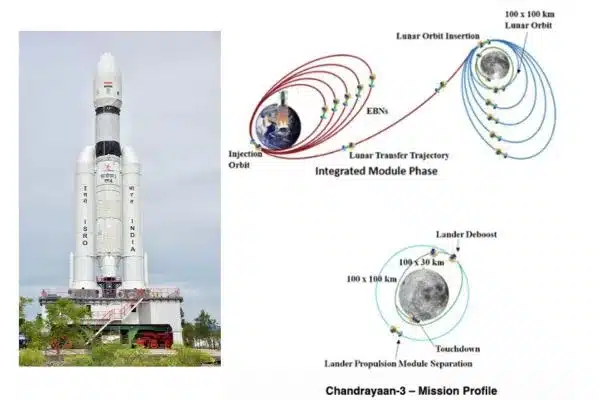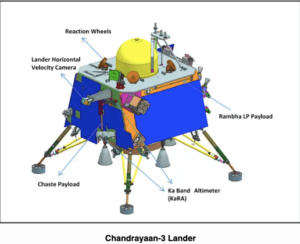Why Chadrayan was on an elliptical Trajectory to Moon: Learn 6 Reasons
Why space crafts (like Chadrayan) are in orbital for landing on the moon’s surface
Spacecraft are placed in orbit around the Moon before landing for several reasons:
- Reducing Speed: The spacecraft approaches the Moon at a high velocity, often thousands of meters per second. Placing the spacecraft in lunar orbit allows it to gradually reduce its speed through controlled engine burns, making the landing safer and more precise.
- Selecting Landing Site: Orbiting the Moon provides a better vantage point for selecting a suitable landing site. This allows mission controllers to assess the terrain, obstacles, lighting conditions, and other factors to choose the safest and most scientifically interesting location for landing.
- Communication: Maintaining line-of-sight communication with Earth is easier from lunar orbit compared to being on the surface. This ensures that the spacecraft can relay important data and receive instructions throughout the descent and landing phases.
- Avoiding Hazards: The Moon’s surface has various hazards, such as craters, boulders, and uneven terrain. By surveying the surface from orbit, mission planners can avoid potential landing hazards and select a smoother area for landing.
- Refining Trajectory: Once in lunar orbit, the spacecraft can fine-tune its trajectory based on real-time observations and measurements. This allows for adjustments to the landing approach and path to ensure a more accurate and safe landing.
- Preparation and Testing: Being in lunar orbit provides a final opportunity to perform system checks, calibrations, and other preparations before committing to the landing. If any issues arise during this phase, there’s still a chance to abort the landing and return to Earth.
- Backup Plans: In case of unforeseen issues or emergencies during the landing attempt, being in orbit provides a backup plan. If the initial landing attempt encounters problems, the spacecraft can return to orbit and reevaluate the situation before attempting another landing.
- Scientific Observation: While in lunar orbit, the spacecraft can also perform scientific observations and experiments, taking advantage of its unique vantage point to gather valuable data about the Moon’s surface, composition, and other characteristics.
Overall, placing a spacecraft in lunar orbit before attempting a landing allows for careful planning, precise trajectory adjustments, and safer execution of the landing, thereby increasing the chances of a successful mission.
Spacecraft often enter lunar orbit in an elliptical trajectory before attempting a landing on the Moon. This elliptical orbit serves several important purposes:
- Energy Efficiency: Elliptical orbits allow spacecraft to take advantage of the principles of orbital mechanics to conserve energy. By entering an elliptical orbit, the spacecraft can use its engines more efficiently to perform orbital adjustments. It can perform engine burns at the periapsis (closest point to the Moon) to increase its speed and raise the apoapsis (farthest point from the Moon), and vice versa. This technique, known as a Hohmann transfer orbit, minimizes the amount of fuel required for orbital maneuvers.
- Safety and Precision: Entering an elliptical orbit allows the spacecraft to approach the Moon at a controlled pace. It gives mission controllers more time to assess the landing site, refine the landing trajectory, and make any necessary adjustments to ensure a safe and precise landing. This is particularly important for avoiding hazards and ensuring a successful landing.
- Communications and Data Relay: The elliptical orbit provides good communication opportunities with Earth. As the spacecraft comes closer to Earth during the apoapsis of its orbit, it has better line-of-sight communication for relaying data, receiving instructions, and sending status updates to mission control. This is crucial during the critical phases of descent and landing.
- Final Preparations: While in the elliptical lunar orbit, the spacecraft can perform final checks, calibrations, and preparations before committing to the landing. It provides a period of time to verify that all systems are functioning properly and that the spacecraft is ready for the landing attempt.
- Backup and Aborts: If any issues arise during the descent or landing sequence, being in an elliptical orbit provides a safety margin. The spacecraft can perform an abort maneuver and return to a safer orbit if necessary, giving mission controllers more time to assess the situation and make decisions.
- Scientific Observation: Just like in a circular orbit, an elliptical orbit allows the spacecraft to perform scientific observations and data collection from various altitudes above the lunar surface. This provides valuable information about the Moon’s surface, composition, and other characteristics.
In summary, using an elliptical orbit before landing on the Moon allows spacecraft to conserve energy, ensure safety and precision during the landing attempt, maintain communication with Earth, perform final preparations, and have backup options in case of emergencies. This orbital strategy optimizes the chances of a successful lunar landing mission.
Why do spacecraft (Chadrayan) round the earth in an elliptical trajectory and enter into the moon`s orbit in an elliptical way before landing on the moon?
Spacecraft use elliptical trajectories when entering Earth’s orbit and then transferring to the Moon’s orbit for several reasons:
Earth Orbit (Elliptical Trajectory):
- Energy Efficiency: Elliptical orbits, particularly highly elliptical orbits like Molniya orbits, can be more fuel-efficient for certain missions. These orbits take advantage of gravitational assists from Earth’s rotation to achieve higher apogee altitudes (farthest point from Earth) with less energy expenditure.
- Communication: Depending on the orbital parameters, elliptical orbits can provide longer periods of better communication with ground stations on Earth, especially when the spacecraft is closer to apogee.
- Observation: Elliptical orbits can offer extended observation periods over specific regions on Earth, which is useful for various purposes such as Earth observation, remote sensing, and scientific research.
Transferring to the Moon’s Orbit (Elliptical Trajectory):
- Energy Conservation: Using an elliptical trajectory for transferring from Earth to the Moon is energy-efficient due to the principles of orbital mechanics. A Hohmann transfer orbit, which is often used for interplanetary missions, allows the spacecraft to move between two orbits with minimal fuel consumption.
- Slowdown and Capture: The spacecraft uses the Moon’s gravity to slow down as it moves away from Earth. This helps the spacecraft transition from Earth’s orbit to the Moon’s orbit while minimizing the need for excessive propulsion.
- Precision: An elliptical trajectory allows mission planners to fine-tune the spacecraft’s path and adjust the timing of critical maneuvers, such as the lunar orbit insertion burn. This precision is important for achieving the desired lunar orbit and ensuring a safe landing.
- Landing Site Selection: An elliptical lunar orbit gives the spacecraft more time to observe potential landing sites on the Moon’s surface, helping mission controllers select a safe and scientifically valuable location for landing.
- Communication and Data Relay: Similar to Earth orbits, elliptical lunar orbits provide windows of improved communication with Earth, allowing for data relay and mission control throughout the lunar approach and landing phases.
Overall, elliptical trajectories are employed for their energy efficiency, communication benefits, observation capabilities, and the ability to achieve precision during critical maneuvers. By utilizing these trajectories, spacecraft can efficiently transfer from Earth orbit to lunar orbit, make necessary observations and adjustments, and ultimately prepare for a successful landing on the Moon.
Why does Chadrayan round the earth in an elliptical trajectory and enter the moon`s orbit in an elliptical way before landing on the moon?
Chandrayaan-2 is an Indian lunar exploration mission launched by the Indian Space Research Organisation (ISRO). It consisted of an orbiter, a lander named Vikram, and a rover named Pragyan. The mission’s primary goal was to explore the Moon’s south polar region. However, the mission failed due to a software glitch. ISRO then re-attempted a lunar landing with Chandrayaan-3, which was launched on 14 July 2023. On 23 August 2023, chandrayan 3 managed to land.
Elliptical Earth Orbit:
- Energy Efficiency: Elliptical orbits can be more energy-efficient for certain missions. By using gravitational assists from Earth’s rotation and carefully planned engine burns, the spacecraft can achieve the desired energy conditions to transfer to the Moon’s orbit while minimizing fuel consumption.
- Communication: Depending on the apogee (farthest point) of the elliptical orbit, the spacecraft can have longer periods of improved communication with ground stations on Earth. This is particularly valuable during critical mission phases, such as launch, orbital insertion, and landing.
- Observation: An elliptical Earth orbit can provide extended observation opportunities for remote sensing, scientific research, or specific regions on Earth, depending on the mission’s objectives.
Elliptical Lunar Orbit:
- Energy Conservation: The spacecraft can use an elliptical trajectory to transfer from Earth orbit to lunar orbit in an energy-efficient manner. This involves a series of orbital maneuvers, often using the Moon’s gravity as a natural assist, to adjust the spacecraft’s trajectory and velocity.
- Capture by Moon’s Gravity: An elliptical lunar orbit allows the spacecraft to be gradually captured by the Moon’s gravity. The spacecraft can perform a controlled burn at the right point in the trajectory to slow down and enter lunar orbit.
- Landing Preparation: While in lunar orbit, the spacecraft can perform observations of potential landing sites, assess surface conditions, and gather crucial data to ensure a safe and successful landing. An elliptical orbit provides additional time for these preparations.
- Data Relay: The spacecraft can maintain a line of sight with Earth for extended periods, facilitating communication, data relay, and command execution throughout the lunar mission.
- Maneuver Flexibility: An elliptical lunar orbit allows for flexibility in adjusting the spacecraft’s trajectory for a precise landing. Fine-tuning the approach and landing trajectory is essential to avoid hazards and ensure a successful landing.
Keep in mind that mission design choices can vary based on specific mission objectives, available technologies, and scientific goals. If you’re looking for the most up-to-date information on Chandrayaan-2 or other lunar missions, I recommend checking official sources from space agencies like ISRO or other reliable space exploration news outlets.

